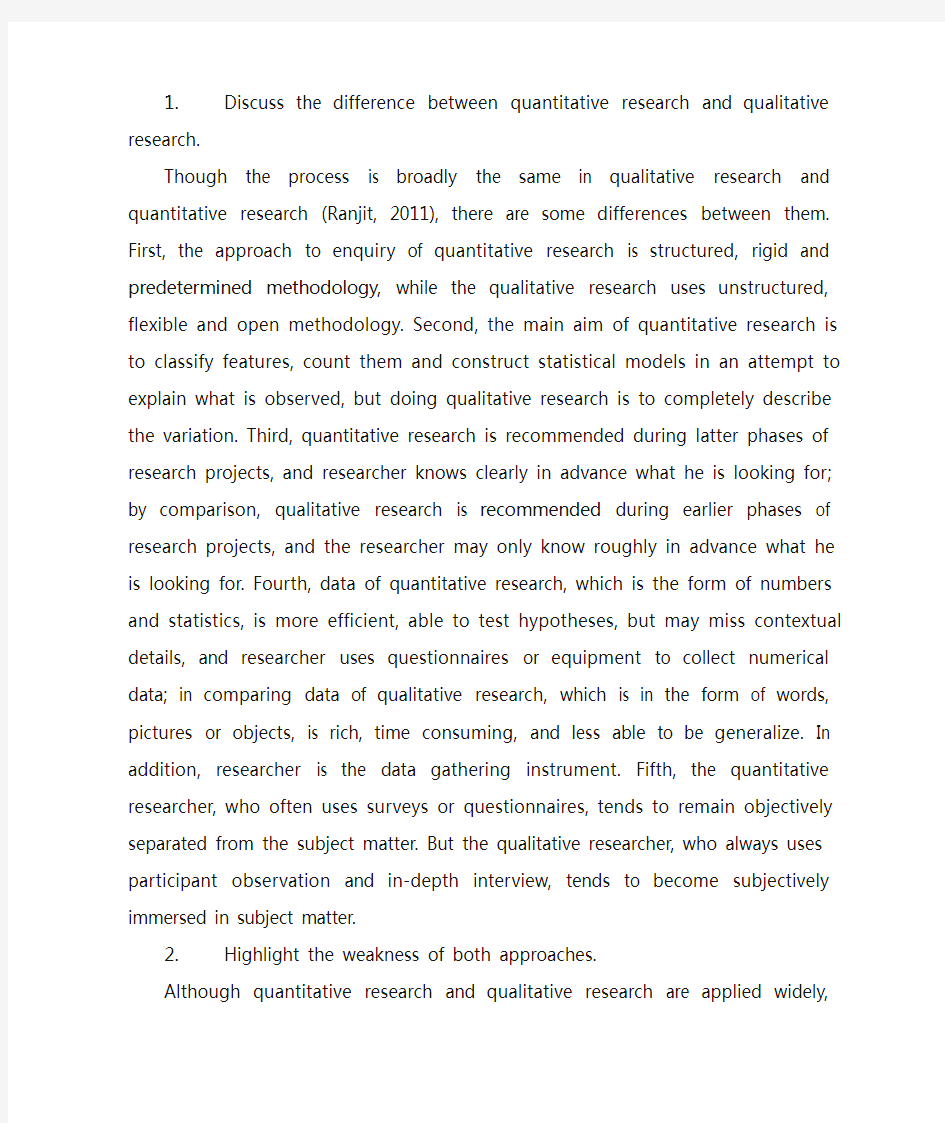quantitative research and qualitative research


1.Discuss the difference between quantitative research and qualitative
research.
Though the process is broadly the same in qualitative research and quantitative research (Ranjit, 2011), there are some differences between them. First, the approach to enquiry of quantitative research is structured, rigid and predetermined methodology, while the qualitative research uses unstructured, flexible and open methodology. Second, the main aim of quantitative research is to classify features, count them and construct statistical models in an attempt to explain what is observed, but doing qualitative research is to completely describe the variation. Third, quantitative research is recommended during latter phases of research projects, and researcher knows clearly in advance what he is looking for;
by comparison, qualitative research is recommended during earlier phases of research projects, and the researcher may only know roughly in advance what he is looking for. Fourth, data of quantitative research, which is the form of numbers and statistics, is more efficient, able to test hypotheses, but may miss contextual details, and researcher uses questionnaires or equipment to collect numerical data; in comparing data of qualitative research, which is in the form of words, pictures or objects, is rich, time consuming, and less able to be generalize. In addition, researcher is the data gathering instrument. Fifth, the quantitative researcher, who often uses surveys or questionnaires, tends to remain objectively separated from the subject matter. But the qualitative researcher, who always uses participant observation and in-depth interview, tends to become subjectively immersed in subject matter.
2.Highlight the weakness of both approaches.
Although quantitative research and qualitative research are applied widely, both of them have weaknesses. In term of quantitative research, first, lager samples are required, as a result, it is easy to make statistical error and undermine the accuracy or validity of a quantitative.
Second, the researcher might miss phenomena occurring and contextual details because of the focus on the theory or hypothesis testing rather
than on theory or hypothesis generation. Third, the data is just in the form of numbers and statistics. As Fred said, there is no such thing as quantitative data. Everything is either 1 or 0 (Miles & Huberman, 1994).
On the other hand, in term to qualitative research, first, it is difficult to make quantitative predictions; as a result, it is difficult to test hypotheses and theories with large participant pools. Second, it might have lower credibility with studying fewer causes. Besides the reliability of qualitative research is weakened by that fact that the process is under-standardized and relies on the insights and the abilities of the observer (Duffy, 1985). Third, it generally takes more time to analyze the data when compared to quantitative research. Fourth, the results are more easily influenced by the research’s personal biases, because the analysis is subjective and small sample size is dealt with.
3.Provide suggestions to overcome those weaknesses.
Doing mixed research combining the quantitative research and qualitative research can overcome those weaknesses when using one’s strengths to overcome the other weaknesses. For instance, words and pictures can be used to add meaning to numbers, and numbers can be used to add precision to words and pictures. As a result, the data would be more efficient, able to test hypotheses, involve contextual details and able to be generalized, which makes contribution to obtain higher credibility. As both approach have strengths and weaknesses, “neither one is markedly superior to the other in all respects” (Ackroyd & Hughes, 1992). In many studies, combining both quantitative and qualitative approaches is needed.
